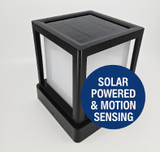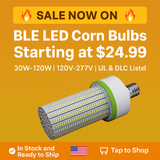Lumens or Wattage? Which Metric Should I Use In Selecting An LED Product?
Lumens, Wattage???
Remember the good old days when a Light bulb or Light fixtures brightness was simply a measure of wattage. The higher the wattage or Power (P=EI for you electrophiles) the Brighter the Bulb or Light Fixture. While Color Temperature was a viable concern, thing just were all so simple then. If you wanted more light simply increase the wattage.
Now, It's not that simple. With the advent of Induction Lighting and LED Lighting Technologies one must be concerned with the Lumens per Watt ratio. We have all come to understand that the price of Electricity will never come down. It is on a continuing trend upward , causing the bean counters to recognize the tremendous monetary saving realized in the utilization of LED and Induction Lighting Technologies. This coupled with the technological increases in the efficiency of LED's, causes us to have to reexamine how we select our Light fixtures and Bulbs, with the goal being, to provide the required light at the lowest possible energy consumption.
Lumens / Watts
Instead of Asking about Wattage we need to start asking about how many Lumens/Watt. The Lumens per Watt Metric is a measure is a ratio to assist you in determining the most energy efferent LED light Fixture or Light Bulb. The Higher the amount of Lumens per Watt, The more energy efficient the LED Fixture is. Therefore we need to start thinking in terms of Lumens instead of simply wattage. And in the Case of LED's it can Be Directional Lumens.
It's About Lumens
To demonstrate the point we have provided a simple list below highlighting the estimated Lumen output of standard Incandescent lamps.
150 W= 2600 lm
100W= 1600 lm
75 W= 1100 lm
60 W= 800 lm
40 W=450 lm
25 W= 200 lm
The list below will show the power requirements of an LED Bulb With 100Lm/Watt Ratio that would provide the same lumen output.
26 W= 2600 lm
16 W= 1600 lm
11 W= 1100 lm
8 W= 800 lm
4.5 W=450 lm
2 W= 200 lm
The Energy saving are evident we are looking at a roughly 75% reduction as compared to incandescent.
Let's Raise the Bar and Test using 150Lm/Watt Ratio LED Lamp
17 W= 2600 lm
11 W= 1600 lm
7 W= 1100 lm
5 W= 800 lm
3 W=450 lm
1 W= 200 lm
In the last Comparison the energy savings came in at roughly 90%.
Thus all thing being equal it becomes obvious that the higher lumen to Watt led product would be a better buy .
We would Love to hear from you Feel Free to contact Us anytime. :-)
For technical questions, Do not hesitate to call us toll free at 855-ILF-BULB. Our customer service and technical support teams are available from 8:30 a.m. to 5 p.m. EST Monday-Friday.
Recent Posts
-
How Long Will Solar Powered Lighting Operate in the Rain?
How Solar Light Fixtures Can Run for 10 Rainy Days If you’ve ever wondered how a Commercial solar li …Jul 30th 2025 -
Spotlight - The IL-SPG54 Smart Solar Walkway Light: Where Performance Meets Simplicity
Introducing the IL-SPG54 Smart Solar Walkway Light: Where Performance Meets Simplicity When it comes …Jun 16th 2025 -
Corn Bulb Sale - While supplies last!
⚡ Limited Time Sale – BLE Series Corn Lamps Starting at $24.99! Stock up now while supplies last – p …Jun 11th 2025





